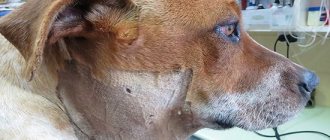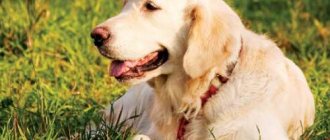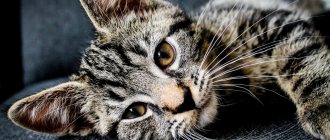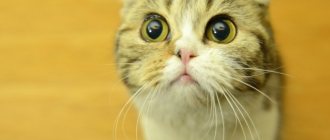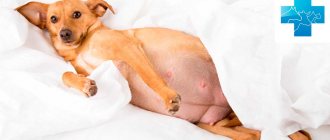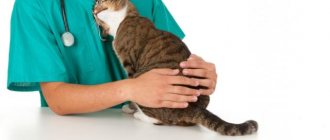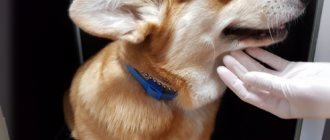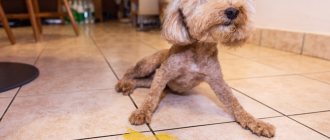Seasonal shedding in dogs of almost all breeds is completely normal. It occurs in the spring, when the body renews itself and “frees itself” from old hair that has lost density and elasticity.
Shedding can be protracted if the animal has been sick for a long time or has undergone surgery. Also, the process can be lengthy if there is a deficiency of vitamins in its food, especially vitamin A and group B. But when molting, the coat can thin out without baldness and the appearance of inflamed, irritated areas of the skin.
If the dog reacts painfully to touch, whines, itches, and its skin is inflamed, with traces of suppuration, scars, dandruff or signs of flaking, we are talking about the presence of a disease. And this already requires a visit to the veterinary clinic.
Causes of the disease
If natural causes of hair loss are excluded, then the causes of dog baldness
there may be the following:
- Violations in hygienic care of animals.
- A sharp decrease in immunity.
- Malnutrition.
- Lack of vitamins.
- Elderly age.
- Metabolic disorders.
- Allergies to food or external sources.
- Hormonal imbalances.
- The presence of helminths in the body.
- Skin infections of a fungal or bacterial nature.
- Subcutaneous mites.
Since there are many reasons for hair loss, and the symptoms are similar, only a veterinarian can identify the true disease that led to the problem when examining the animal.
Therefore, if simple shedding is excluded, and there are reasons to suspect the presence of a disease, you need to take the dog to the clinic as quickly as possible.
Lack of nutrition
Shreds of hair can fall out from a dog either due to general exhaustion and nutritional deficiency, or due to a lack of a number of essential elements. A general lack of nutrients can be determined by the clinical picture, but to make a diagnosis and select the correct treatment, it is necessary to do a biochemical blood test.
Clinical signs of deficiency of various vitamins:
- A-vitaminosis is accompanied by follicular hyperkeratosis, poor coat condition, and scales on a large surface of the body;
- vitamin B7 deficiency leads to hair loss around the eyes, crusting on the face, general lethargy and diarrhea;
- lack of nicotinic acid leads to dermatitis, ulceration of the mucous membranes, and pleurisy.
For treatment, it is necessary to normalize the dog’s diet. First of all, additional vitamin feed is introduced. It is also recommended to make intramuscular injections of complex vitamins and microelements.
Which breeds are more susceptible
Absolutely any dog can get sick, but dogs that are long-haired and have folds of skin along their body are more susceptible to baldness and coat problems. These are Mastino Napolitano, Bullmastiff, Dogue de Bordeaux, Chow Chow, Shar Pei, Boxer, English and French bulldogs, Pug, Chihuahua and some other breeds.
Due to their anatomy, large folds of skin can rot, accumulate infection, become inflamed and lead to the development of diseases in which the coat becomes very thin or falls out altogether.
Main symptoms
An attentive owner will immediately notice that the dog is behaving inappropriately:
- The animal is restless, cannot sleep peacefully, often jumps off, itches, and may whine and howl.
- Scratch marks appear on the skin, and the vegetation thins out.
- In those places that are devoid of hair, inflamed, swollen areas appear, which can look like inflamed wounds or even like purulent wounds.
- If the affected area is around the eyes, they may become inflamed, swollen, and mucous or purulent discharge may appear.
- The most commonly affected areas of the body are the muzzle, armpits, inguinal folds, genital area, undertail and abdomen.
- The dog may lose his appetite and not even respond to his favorite dish or tasty brain bone.
- When trying to examine a sore spot, the dog becomes aggressive and can even bite a person, including its own owner.
- If the skin is severely damaged, the animal's temperature rises, it becomes lethargic, apathetic, lies indifferently, or even tries to hide in a corner.
Before taking measures, you must undergo an examination in a clinic, since skin diseases are not always the cause of baldness. Such problems need to be treated “from the inside”, and only a doctor can identify them.
Special grooming procedures
Properly selected vitamin and mineral complexes and nutritional supplements can reduce the duration and intensity of the seasonal process. If they do not have a noticeable effect, you should consult a veterinarian. He will tell you what to do when your dog sheds heavily. You can also use grooming services.
Express molt
Professionally performed combing is called express shedding. It is carried out by a master in a hairdressing salon for animals, that is, in a grooming salon.
Express shedding includes brushing with a furminator brush, bathing with shampoo and conditioner, and drying with a special hairdryer. The procedure makes it possible to remove up to 90% of dead hair, and the effect lasts up to 3 months.
Trimming
Removing dead hair by plucking is called trimming. This is a health and hygiene procedure carried out in the salon. Trimming is recommended for wire-haired breeds (listed above), which find it difficult to shed dead particles on their own. A salon procedure is performed on average once a quarter, which allows you to maintain a neat appearance for your pet.
Diagnostics in a veterinary clinic
An experienced veterinarian can identify some characteristic signs of a particular disease by appearance, but to obtain an accurate diagnosis you will still have to undergo an examination and pass the necessary tests.
First of all, the clinic will rule out ticks, fungal and bacterial infections. The cause of hair loss on a dog's body can be eczema, pyoderma, lack of vitamins or general exhaustion.
Also, wool actively sheds after childbirth, severe or prolonged illness, or surgery. During the examination, the doctor will definitely find out these circumstances from the animal owner.
Only after an accurate diagnosis has been made will the veterinarian prescribe the necessary treatment and select the right medications.
Treatment method and prognosis
Owners of sick dogs need to understand that using medications intended for humans can be very dangerous and harmful to the dog. You can only use medications prescribed by a veterinarian and strictly in the prescribed dosage.
The method of treatment and choice of medications depends entirely on the cause of the loss. If the cause is a bacterial infection, the dog will be prescribed a course of antibiotics. If the dog is infected with fungi, lichen or mites, it will be necessary to undergo specialized treatment, which usually includes a course of medications internally and the use of ointments, creams or powders externally.
In case of hormonal disorders, the doctor can select the appropriate treatment to correct the condition. Often, with recurring problems, owners are advised to sterilize the animal in order to rid it of hormone swings and avoid recurrence of hair loss.
If there is an acute shortage of vitamins, you need to adjust the dog’s menu, saturating it with the necessary substances. In case of allergies, the allergen is identified and the dog is isolated from it. Sometimes hair loss occurs due to an excess of protein in the diet. In this situation, it is necessary to change the diet by cutting down on proteins and adding more vegetables and cereals to the dog’s food.
Hair loss around the tail and genitals is often caused by the presence of helminths. Some of them lay eggs outside the body: on the delicate skin of the genitals and in the folds of the anus. The dog scratches these places, infection gets into the abrasions, and inflammation with swelling occurs.
As the infection spreads, it causes damage to the hair follicles, and the hair in the affected areas falls out - partially or completely. In this case, the treatment will be twofold. First, it is necessary to carry out deworming, eliminating the cause of the itching. Then the inflamed areas of the skin are treated.
Most often, a bacterial infection settles in scratches, so the dog is prescribed a course of antibiotics and ointments with them externally. In most cases, hair loss can be dealt with quickly, the infection goes away and the hair grows back - thick, dense and elastic.
Sometimes owners themselves become the cause of their pet's illness. An excessive desire for cleanliness is just as harmful as a complete disregard for hygiene. If you wash your dog too often, the skin and hair's defenses will be weakened and unable to resist. The hair will dry out and break, and the skin will peel off. As a result, bald spots and flaking similar to dandruff may appear in the coat.
To get rid of this condition, you need to stop tormenting your dog with constant washing and use exclusively shampoos and other products for animals, and not aromatic gels for people. In addition, with severe dry skin and coat, as with baldness in aging dogs, you need to enrich the menu with healthy polyunsaturated fatty acids and vitamins.
Hair loss during shedding
Dog hair lasts a certain period of time, after which it falls out, and a new one grows in its place. In most cases, this is a natural process, even if the fur comes out in clumps. Depending on the type of keeping and other external factors, dogs have several types of shedding:
- seasonal;
- age;
- continuous;
- pathological
The first moult in puppies results in the replacement of soft juvenile hair with coarser adult hair. Then twice a year dogs experience seasonal shedding. Under the influence of external stimuli (lighting, temperature), endocrine regulation is triggered, triggering the growth of the undercoat and longer guard hair. A similar procedure occurs in the spring, when downy hair begins to fall out. Seasonal molting lasts for several weeks (up to 1.5-2 months) and begins from the head, gradually moving along the back to the tail and limbs.
In animals kept in warm apartments throughout the year, seasonal molting is not pronounced. Instead, hair falls out as the follicles age and die. This coat change is not noticeable, but can intensify under various external influences. In this case, pathological molting develops, which is associated with parasitic, infectious and other diseases.
What to do at home
The dog should be treated only as prescribed by a doctor, without doing anything on your own. At home, a sick dog needs to be provided with a dry, clean and warm place where no one will disturb it. The bedding must be changed regularly, washed thoroughly and ironed if a tick or fungal or bacterial infection is detected on the dog.
Medicines are given as prescribed by the veterinarian. The dog is provided with high-quality food, clean water, and care is taken to ensure that it does not become depressed or experience severe discomfort.
If the animal scratches its wounds, it will have to wear a special protective collar. Owners will have to carefully treat diseased areas of the skin in order to quickly achieve healing and the growth of a healthy shiny coat.
Prevention of alopecia in dogs
To avoid the occurrence of this disease, it is enough to follow simple general recommendations. They provide:
- Regularly examine your pet's skin. It is advisable to carry it out after clipping or washing your pet. When the first signs of afforestation appear, you should immediately consult a doctor.
- Follow the recommendations for caring for the animal's fur. It must be combed out during the molting period, otherwise it will cause skin inflammation and severe itching, which can cause alopecia.
- Providing the dog with a nutritious diet. Your pet's food should contain a large amount of vitamins and minerals. It is especially important to adhere to this rule during the molting period. If you do not know how to feed your dog to prevent hair from coming out, consult your veterinarian on this issue.
- Timely vaccination of the animal and regular deworming.
- Correct selection of accessories for your pet: collar, leash. You need to purchase only high-quality products that do not put pressure on the dog’s neck and do not rub.
The owner also needs to ensure that the pet does not come into contact with other animals or conflict with them, as it can become infected with dermatological diseases from them. If you follow these simple recommendations, you will not encounter alopecia in dogs.
Possible complications
Any disease, if left untreated or if it is chosen incorrectly, can become complicated. In the case of skin diseases with infection, this threatens the dog with the spread of the disease, including general blood poisoning.
If the cause of hair loss is a food allergy, continuing to feed your dog the same food can be fatal. This will lead to disruption of the functioning of internal organs, digestive disorders and the most dangerous consequences, including death.
Extensive damage to the dog’s fur threatens the development of severe infections and their spread throughout the body.

